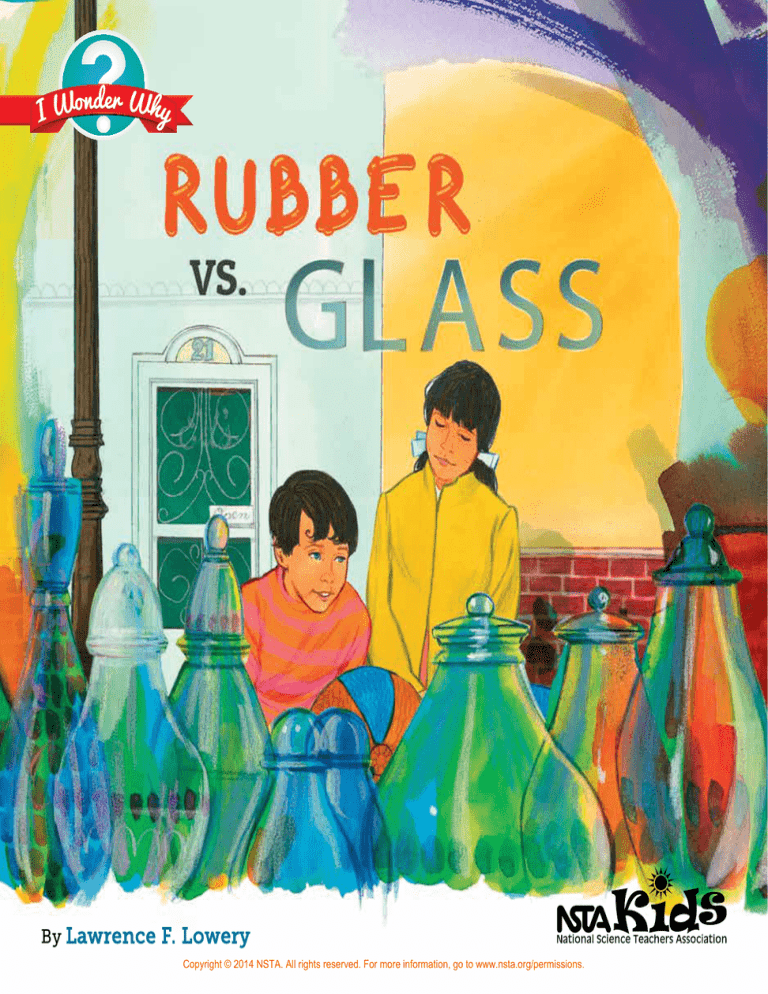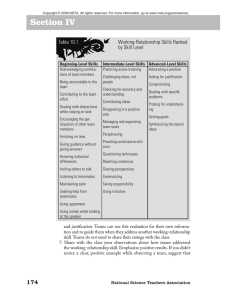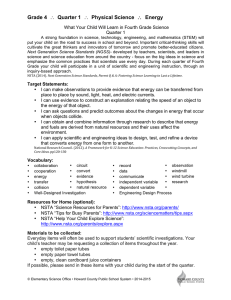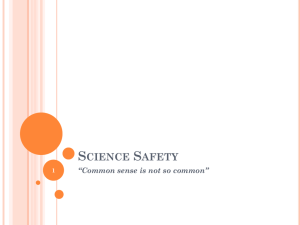
Clouds, Rain, Clouds Again
By Lawrence F. Lowery
Copyright © 2014 NSTA. All rights reserved. For more information, go to www.nsta.org/permissions.
Clouds, Rain, Clouds Again
Copyright © 2014 NSTA. All rights reserved. For more information, go to www.nsta.org/permissions.
Clouds, Rain, Clouds Again
By Lawrence F. Lowery
Illustrated by Phil Smith
Copyright © 2014 NSTA. All rights reserved. For more information, go to www.nsta.org/permissions.
™
Claire Reinburg, Director
Wendy Rubin, Managing Editor
Andrew Cooke, Senior Editor
Amanda O’Brien, Associate Editor
Amy America, Book Acquisitions Coordinator
ART AND DESIGN
Will Thomas Jr., Director
Joseph Butera, Cover, Interior Design
Original illustrations by Phil Smith
T
PRINTING AND PRODUCTION
Catherine Lorrain, Director
NATIONAL SCIENCE TEACHERS ASSOCIATION
David L. Evans, Executive Director
David Beacom, Publisher
1840 Wilson Blvd., Arlington, VA 22201
www.nsta.org/store
For customer service inquiries, please call 800-277-5300.
Copyright © 2014 by the National Science Teachers Association.
All rights reserved. Printed in the United States of America.
17 16 15 14
4 3 2 1
Lexile® measure: 620L
NSTA is committed to publishing material that promotes the best in inquiry-based science education. However, conditions of actual use may vary, and the safety
procedures and practices described in this book are intended to serve only as a guide. Additional precautionary measures may be required. NSTA and the authors do
not warrant or represent that the procedures and practices in this book meet any safety code or standard of federal, state, or local regulations. NSTA and the authors
disclaim any liability for personal injury or damage to property arising out of or relating to the use of this book, including any of the recommendations, instructions,
or materials contained therein.
PERMISSIONS
Book purchasers may photocopy, print, or e-mail up to five copies of an NSTA book chapter for personal use only; this does not include display or
promotional use. Elementary, middle, and high school teachers may reproduce forms, sample documents, and single NSTA book chapters needed for
classroom or noncommercial, professional-development use only. E-book buyers may download files to multiple personal devices but are prohibited
from posting the files to third-party servers or websites, or from passing files to non-buyers. For additional permission to photocopy or use material
electronically from this NSTA Press book, please contact the Copyright Clearance Center (CCC) (www.copyright.com; 978-750-8400). Please access
www.nsta.org/permissions for further information about NSTA’s rights and permissions policies.
Library of Congress Cataloging-in-Publication Data
Lowery, Lawrence F., author.
[I like rubber, I like glass]
Rubber vs. glass / Lawrence F. Lowery ; illustrated by Phil Smith.
pages cm -- (I wonder why)
Originally published: New York: Holt, Rinehart and Winston, 1969 under title: I like rubber, I like glass.
Audience: K to 3.
ISBN 978-1-938946-50-9
1. Rubber--Juvenile literature. 2. Glass--Juvenile literature. I. Smith, Phil, 1930- illustrator. II. Title. III. Title: Rubber versus glass.
TS1890.L68 2014
620.1’94--dc23
2014019380
Cataloging-in-Publication Data are also available from the Library of Congress for the e-book.
Introduction
he I Wonder Why series is a set of science books
created specifically for young learners who are in
their first years of school. The content for each
book was chosen to be appropriate for youngsters who are beginning to construct knowledge of the
world around them. These youngsters ask questions. They
want to know about things. They are more curious than they
will be when they are a decade older. Research shows that
science is students’ favorite subject when they enter school
for the first time.
Science is both what we know and how we come to know
it. What we know is the content knowledge that accumulates
over time as scientists continue to explore the universe in
which we live. How we come to know science is the set of
thinking and reasoning processes we use to get answers to
the questions and inquiries in which we are engaged.
Scientists learn by observing, comparing, and organizing the objects and ideas they are investigating.
Children learn the same way. The thinking processes
are among several inquiry behaviors that enable us to
find out about our world and how it works. Observing,
comparing, and organizing are fundamental to the more
advanced thinking processes of relating, experimenting,
and inferring.
The five books in this set of the I Wonder Why series
focus on some content of the physical sciences. The physical sciences consist of studies of the physical properties and
interactions of energy and inanimate objects as opposed to
the study of the characteristics of living things.
Physics, along with mathematics and chemistry, is one
of the fundamental sciences because the other sciences,
such as botany and zoology, deal with systems that seem
to obey the laws of physics. The physical laws of matter,
energy, and the fundamental forces of nature govern the
interactions between particles and physical entities such as
subatomic particles and planets.
Copyright © 2014 NSTA. All rights reserved. For more information, go to www.nsta.org/permissions.
These books introduce the reader to several basic
physical science ideas: exploration of the properties of some
objects (Rubber vs. Glass), interaction with the properties of
light and the effect of light on objects (Light and Color; Dark
as a Shadow), the nature of waves and sound (Sounds Are
High, Sounds Are Low), and the use of simple machines to
accomplish work (Michael’s Racing Machine).
The information in these books leads the characters and
the reader to discover how opaque objects block light and cast
shadows, that different objects have special and useful properties (glass and rubber), that simple mechanical tools reveal
some of the laws of physics, and that “nontouchable items” such
as light and sound energy also have distinctive properties.
Each book uses a different approach to take the reader
through simple scientific information. One book is expository, providing factual information. Several are narratives that
allow a story involving properties of objects and laws of physics to unfold. Another uses poetry to engage the characters
in hands-on experiences. The combination of different styles
of artwork, different literary ways to present information, and
directly observable scientific phenomena brings the content
to the reader through several instructional avenues.
In addition, the content in these books supports the criteria set forth by the Common Core State Standards. Unlike
didactic presentations of knowledge, the content is woven
into each book so that its presence is subtle but powerful.
The science activities in the Parent/Teacher Handbook section in each book enable learners to carry out their
own investigations related to the content of the book. The
materials needed for these activities are easily obtained, and
the activities have been tested with youngsters to be sure
they are age appropriate.
After completing a science activity, rereading or referring back to the book and talking about connections with
the activity can be a deepening experience that stabilizes
the learning as a long-term memory.
All of a sudden, Mary spotted a gift shop.
She stopped running and pulled Bill to a halt.
“Bill,” she cried out, “look at all the colors and
shapes of glassware in the shop window.”
Bill was not interested in glass. “All that
glass can break,” he said. “Rubber bends and
stretches. Rubber bounces when dropped.
Glass breaks.”
Copyright © 2014 NSTA. All rights reserved. For more information, go to www.nsta.org/permissions.
“Glass can bounce, too. Just watch,” answered his sister
as she pulled a red glass marble out of her pocket and
dropped it on the sidewalk. “See, glass bounces.”
Bill tried to catch the bouncing marble but missed. The
marble rolled off the sidewalk and stopped near the wheels
of a car parked at the curb.
“All right, all right, glass bounces,” agreed Bill. “But you
don’t see any glass tires on that car, do you?”
Copyright © 2014 NSTA. All rights reserved. For more information, go to www.nsta.org/permissions.
Clouds, Rain, Clouds Again
A
friendly debate leads twins Bill
and Mary to compare rubber balls,
rafts, and gloves with glass marbles,
greenhouses, and jars, objects that at first seem very
different. A field trip teaches them that both rubber and glass can
bend, bounce, stretch, and even melt. This lively story introduces the
concept of properties. As scientists know, properties are characteristics
that help us understand the traits of substances all around us if—like Bill
and Mary—we observe closely.
Rubber vs. Glass is part of the I Wonder Why book series, written to ignite
the curiosity of children in grades K–6 while encouraging them to become
avid readers. These books explore the marvels of light, color, machines, sound,
and other phenomena related to physical science. Included in each volume is
a Parent/Teacher Handbook with coordinating activities. The I Wonder Why
series is written by an award-winning science educator and published by NSTA
Kids, a division of NSTA Press.
Grades K–6
Lexile® measure: 620L
PB330X11
ISBN: 978-1-938946-50-9
Copyright © 2014 NSTA. All rights reserved. For more information, go to www.nsta.org/permissions.



